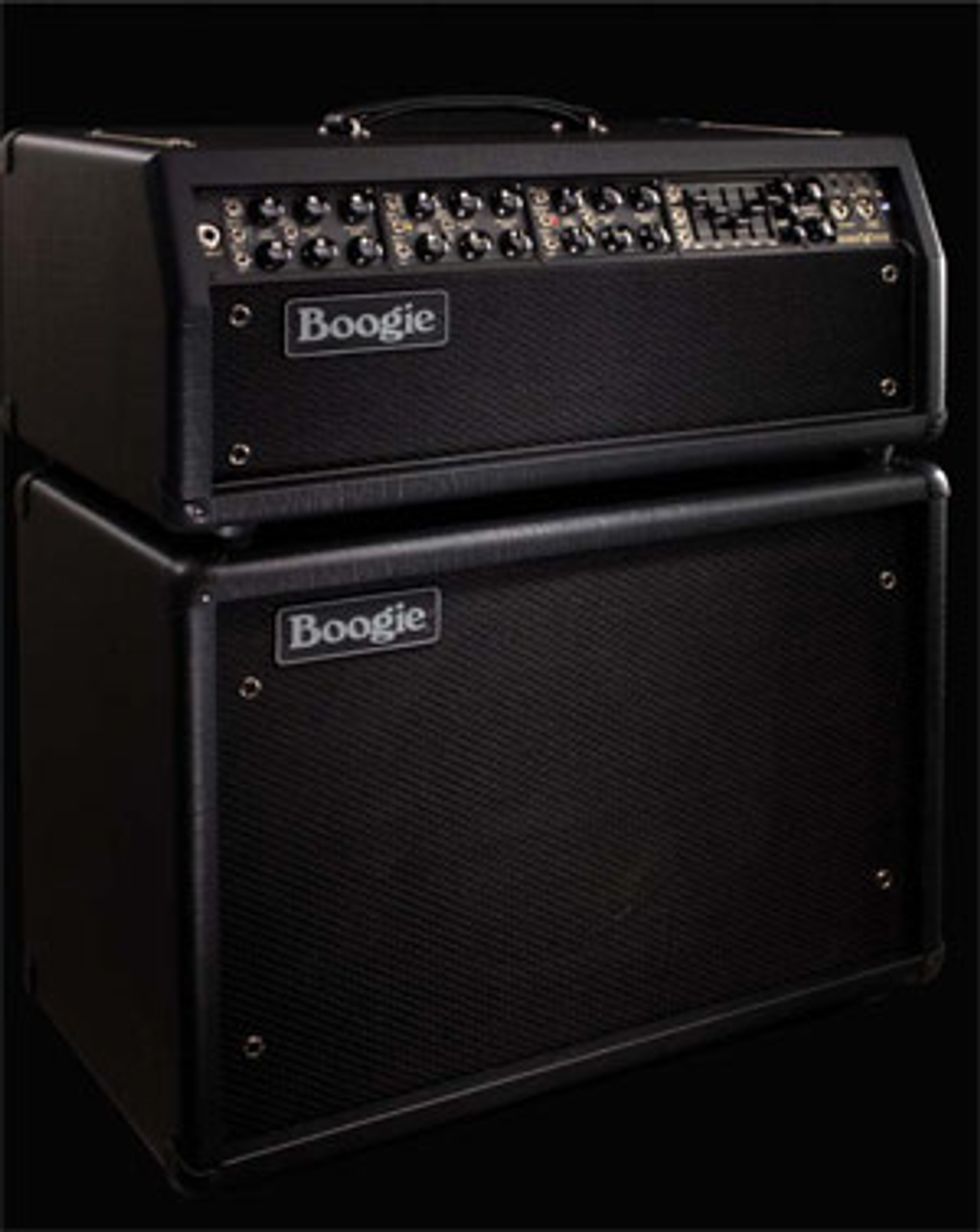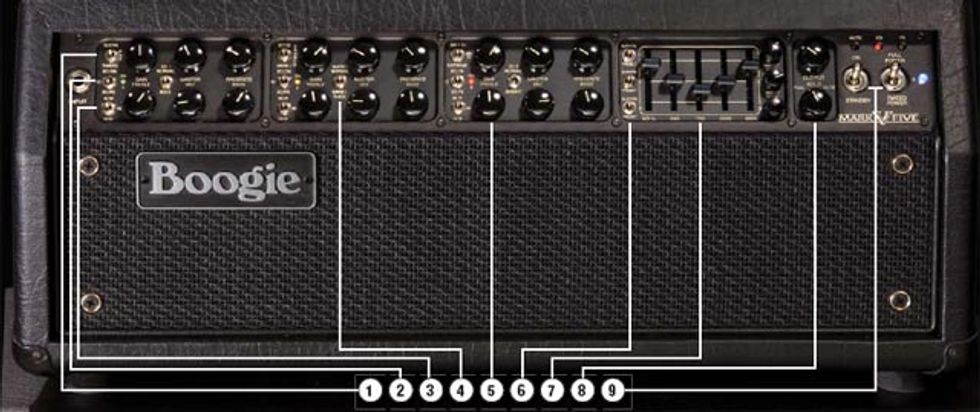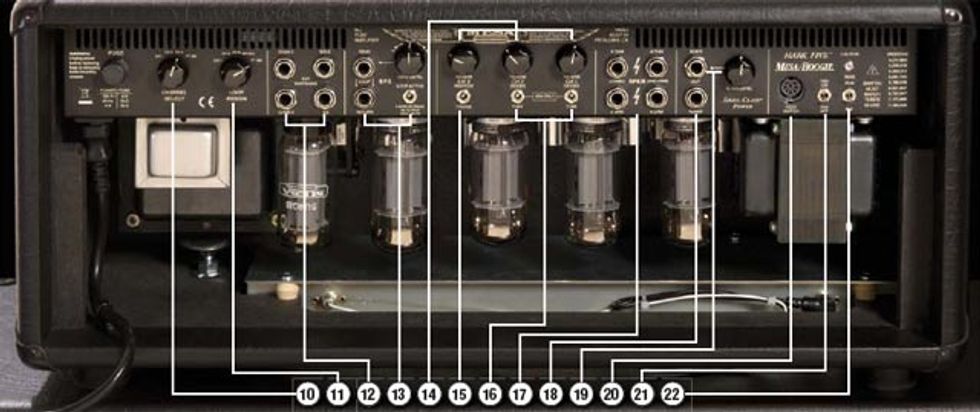A detailed look at Mesa Boogie''s new Mark V amp
mesaboogie.com
 The Mark V is really a collection of amplifiers.
There are far too many circuits and sounds
to think of it as merely an amp. From the
groundbreaking Mark I that introduced the
world to high gain with its cascading preamp,
to the Mark II—the world’s first high gain
Dual Mode Channel Switching amplifier—and
its later siblings that introduced Simul-Class
power, from the Mark III that ushered in the
era of 3 Channel footswitching performance,
to the Mark IV which gave all this power individual
control, the Mark V is the embodiment
of the last 40 years of guitar amp history.
The Mark V is really a collection of amplifiers.
There are far too many circuits and sounds
to think of it as merely an amp. From the
groundbreaking Mark I that introduced the
world to high gain with its cascading preamp,
to the Mark II—the world’s first high gain
Dual Mode Channel Switching amplifier—and
its later siblings that introduced Simul-Class
power, from the Mark III that ushered in the
era of 3 Channel footswitching performance,
to the Mark IV which gave all this power individual
control, the Mark V is the embodiment
of the last 40 years of guitar amp history.Three distinct channels present the three footswitchable sounds in a simple-to-dial platform, but don’t let that fool you… beneath each set of controls lies another layer of performance. Each preamp Channel contains three distinct Modes that are controlled by a simple minitoggle MODE switch found in the upper left corner of each Channel. This switch is responsible for the voicing of each Channel. In some cases these voicings are related by style and give you important musical differences within a gain structure and sonic theme. In other cases, both gain and EQ are radically altered to achieve drastically different sounds—yet these sounds appear on the same set of controls. This is a result of needing a certain circuit architecture and Tone control string to achieve a particular sound style. Sometimes these extreme mode differences require different Gain and Tone control treatments to achieve a recognizable and iconic sound. In other words, it may require some dialing of the controls when you are touring through the modes. With circuits capable of these extremes, there is simply no way to avoid this.
Features include:
• 3 Fully Independent Channels with 9 Modes (Channel 1: Clean, Fat or Tweed, Channel 2: Edge, Crunch or Mark I, Channel 3: Mark IIC+, Mark IV or Extreme)
• 5 Band Graphic EQ is Footswitchable, Channel Assignable and Selectable between 1 group of 5-Band Sliders or 3 channel specific, variable depth Contour Controls
• Footswitchable, Channel Assignable or True Bypassable All-Tube FX Loop with Send Level Control (over all channels when activated)
• Output Level Control (over all channels when activated)
• True “Hard” Bypass Switch removes FX Loops, Output Level & Solo Level Controls from signal path
Click next to learn more about the Mark V’s features...
mesaboogie.com

| 1. Mode Switch The Mode switch allows you to switch between three separate modes for each of the three channels, totaling nine different amp sounds in one box. |
2. EQ Switch The EQ switch on each channel allows you to select whether you will use the actual sliders or a preset contour. |
3. Multi-Watt Switch The Multi-Watt switch determines the wattage (90, 45, or 10) and configuration of power each preamp channel will be coupled with to create a classic sound. |
| 4. Channel Voicing Switch Each channel has a voicing switch: Normal/ Bold on Channel 1, Normal/Thick on Channel 2 (Mark I only), Normal/Bright on Channel 3. |
5. Channel-Specific Tone Controls
Each channel features Gain, Master, and Presence controls in the top row, and Treble, Mid, and Bass controls in the bottom row. |
6. Sliders/Preset Switch A separate mini-toggle for each channel located in the left side of the Graphic EQ section allows you to select whether you will use the actual sliders to shape your individual EQ curve or a preset contour based on the ever-popular V curve. |
| 7. Graphic EQ On-board 5-band graphic EQ comes at the very end of the signal chain so you can shape the final sound with the only consideration being how much of a certain frequency your speakers, cabinets, and ears can handle. |
8. Output and Solo These two control the overall output level of the Mark V when the effects loop switch on the rear panel is switched into the FX ACTIVE position. Solo provides a footswitchable boost. |
9. Standby/Power Switches Standby shuts down part of the high voltage to the power tubes so that they can rest at idle without wear. A built-in variac is also included on the Power switch so that you may run the entire amp on a reduced voltage “brown-out” condition. |
Click next to check out the back of the amp and read about its channels...

| 10. Channel Select A four-position Channel Select rotary control is provided to access the three channels when the footswitch is not connected or available. |
11. Loop Assign A five-position Loop Assign switch is provided to assign the effects loop to any or all of the channels or select FTSW to trigger the loop on and off with the Mark V footswitch. |
12. External Switching Jacks Four 1/4" external switching phono jacks are provided for remote control of the Mark V channels, EQ and Solo control from a master switcher. |
| 13. Effects Loop The effects loop is fitted with a hard bypass feature that removes a whole tube (two stages) and all associated circuitry from the signal path for the purist who insists on the most direct path to tone in the studio. |
14. Reverb Controls Individual reverb controls for each channel allow you to set the desired mix of the rich all-tube reverb effect for each channel without compromise. |
15. Pentode/Triode Switch A pentode/triode mini toggle switch allows you to choose the wiring configuration on the middle pair of power tubes in Channel 3 only. Pentode produces a bolder, tighter voice that has a more pronounced midrange curve and is excellent for adding percussive authority to lower gain single note solo sounds. Triode softens the attack and scoops the mids a bit more to create a more liquid, legato feel that really shines for high gain styles and faster playing. |
| 16. Switchable Rectifiers Channels 1 and 2 are fitted with individual mini toggles that allow you to choose between the tight, bold higher-headroom response of silicon diodes or the saggier, sweeter low-output looseness of tubes in the 45-watt power setting only. The 90-watt setting automatically selects the silicon diodes and the 10-watt setting requires the tube rectifier to operate safely. |
17. Speaker Outputs Two 8- and 4-ohm speaker outputs are provided and with these jacks almost any speaker cabinet combination can be accommodated. |
18. Tuner Output A 1/4" tuner output is provided and a silent tuning feature has been incorporated so you can tune the instrument onstage without bothering the band or audience. |
| 19. Slave Output/Slave Level Control A slave output and slave level control allows you to capture the full sound of the Mark V, both preamp and power section, for a feed to processing racks and/or additional power amps for big venue applications. |
20. Footswitch Jack The footswitch jack is conveniently located on the right side of the rear panel and accepts a 8-pin male DIN cable. |
21. Cooling Fan The cooling fan is fitted with an on/off switch to allow silent running in the studio or late night practicing in the lower wattage settings. |
| 22. Bias Select A bias select switch is included that allows you to run EL34s in place of the stock compliment of 6L6s. The EL34 style tubes will produce a brighter, skinnier sound that will clip with an enhanced harmonic content. The 6L6s will likely perform better for a wide range of sounds. |
Channels
Channel 1 contains the lowest gain sounds of the three channels and can be thought of as the Rhythm or Clean channel.
Toggle up: tight, skinny CLEAN. Toggle center: a warm, rich FAT clean sound with added lower fundamental. Toggle down: higher gain TWEED. Bold switch: adds punch and cut starting in the high mids to help you stand out in a dense mix and give you an increase in headroom.
Channel 2 is the transitional channel between the low-gain sounds of Channel 1 and the high-gain fury of Channel 3.
Toggle up: stripped, British-inspired EDGE. Toggle center: a thicker, throatier CRUNCH. Toggle down: the iconic high-gain voice of the MARK I. Thick switch: affects the Mark I mode only to add extra gain in the mids for added single note focus.
Channel 3 goes on from there to encompass the best of the Mark Series Overdrive sounds.
Toggle up: the classic voice of the MK II C+. Toggle center: a dose of thick midrange gain combined with a rounding out of the upper harmonic peak of the MARK IV. Toggle down: a full-gain assault that cuts through any mix on the EXTREME setting. Bright Switch: affects all three modes in Channel 3.
mesaboogie.com
